ALLIES’ AMPHIBIOUS/AIRBORNE THRUSTS ACROSS RHINE
Xanten, North Rhine-Westphalia, Germany • March 23, 1945
In the aftermath of Operation Market Garden, the inventive but failed September 1944 thrust into Adolf Hitler’s Germany, came Operation Plunder, another offensive conceived by British Field Marshal Bernard Law Montgomery. (Operation Plunder was the overall name for Montgomery’s 21st Army Group’s crossing the Rhine, but each of of the major elements was known by its own codename.) Operation Plunder kicked off on this date, March 23, 1945, when the first set of 300,000 U.S., British, and Canadian troops crossed the Rhine north of Xanten (the medieval town in North Rhine-Westphalia had been captured by Canadians on March 8) and established bridgeheads near Wesel on the east bank, 90 miles north of the cathedral city of Cologne. Within a week of the start of Operation Plunder, the Allies had taken 30,000 German POWs.
The next day, March 24, Prime Minister Winston Churchill and Field Marshals Montgomery and Viscount Alan Brooke, Chief of the Imperial General Staff, sat on folding chairs around an improvised table drinking tea and enjoying lunch on the Rhine bank. Overhead several thousand Allied aircraft (principally C‑47 Skytrain transports and 1,348 engineless gliders), escorted by a covering contingent of 3,000 fighter planes, were engaged in the largest airborne operation of the war, Operation Varsity, landing over 17,000 American and British troops and masses of supplies, including artillery pieces and vehicles, east of the Rhine in a single day. The paratroopers captured bridges, secured towns, and silenced batteries and machine-gun nests that could have been used by the enemy to delay the advance of Allied ground forces. Gen. James Gavin of the 82nd Airborne Division, who had never before witnessed such a large-scale airborne deployment, described the air show as “an awesome spectacle.” The airborne and land-based offensives, Varsity and Plunder, constituted the last great battle in the West.
The German Wehrmacht’s shock troops, Fallschirmjaeger (English, paratroopers), were thrown in against the Allies, but they offered only slight opposition to the advancing Allies, in the end withdrawing northeast toward Hamburg and Bremen. Wesel, where important roads and rail lines intersected, fell on March 24, the same day Reich Minister of Propaganda Joseph Goebbels confided in his diary that the situation in the West had entered an extraordinarily critical, ostensibly almost deadly, phase. Two days later Gen. George S. Patton’s Third U.S. Army reached Germany’s fifth largest city, Frankfurt am Main, entering the city across the Niederrad bridge in the south. On March 27, Gen. Dwight D. Eisenhower, Supreme Commander of the Allied Expeditionary Force, underscored Goebbels’s worst nightmare, saying in a press interview that the Germans in the West were “a whipped army incapable of throwing in sufficient strength to stop the Allies. . . . The crossing of the Rhine marks the end of one phase of the campaign and the beginning of another.” By the end of the month, the Western Front had moved east of the Rhine and was 200 miles from Berlin, while the Eastern Front (Red Army) was 50 miles from the Nazi capital. The end of the war in Europe was four weeks away.
Operations Plunder and Varsity: Crossing the Rhine River into Germany’s Heartland, March 22–28, 1945
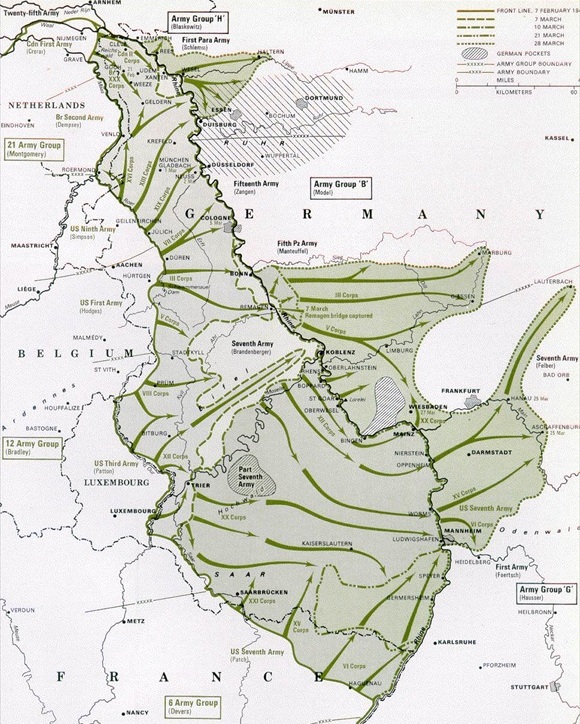 |
Above: Gen. George Patton’s Third U.S. Army crossed the Rhine River west of Mainz and near Oppenheim just before midnight on March 22, 1945 (third arrow up from bottom east of Rhine). The next day the Third Army made another Rhine River crossing near Worms, Germany (second arrow from bottom), while the British Second Army and Canadian First Army launched their assaults (as part of Operation Plunder) further north across the Rhine north of the Ruhr River (hashed area). By early April seven Allied armies had crossed the Rhine and were ready to advance on the Nazis’ capital, Berlin.
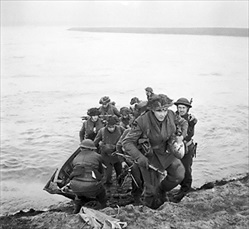 | 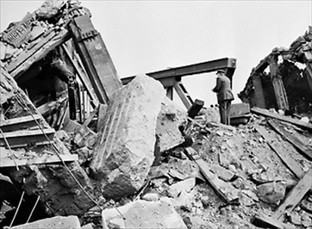 |
Left: Men of the 15th Scottish Division leave their assault craft after crossing the Rhine River near Xanten, North Rhine-Westphalia, March 24, 1945.
![]()
Right: British Prime Minister Winston Churchill (center right in photo) looks over the Rhine River from the ruins of the west end of the bridge at Wesel, North Rhine-Westphalia, March 25, 1945. A watchful Gen. William Simpson, commander of the Ninth U.S. Army, shouted a warning to Churchill that German snipers were still quite active in the area.
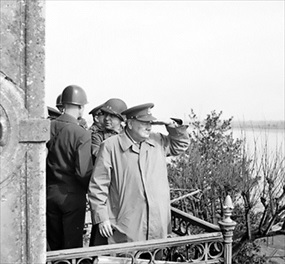 | 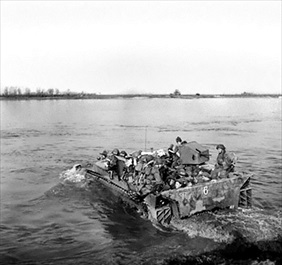 |
Left: Churchill and American generals on a balcony watch Allied vehicles crossing the Rhine into Germany, March 25, 1945.
![]()
Right: Men of the British 5th Dorsetshire Regiment cross the Rhine into Germany in a Buffalo tracked landing vehicle, March 28, 1945.
Royal Air Force Documentary on Operation Varsity (Operation Plunder’s Airborne Component), Part 1 of 2. Be Sure to Watch Part 2
![]()

 History buffs, there is good news! The Daily Chronicles of World War II is now available as an ebook for $4.99 on Amazon.com. Containing a year’s worth of dated entries from this website, the ebook brings the story of this tumultuous era to life in a compelling, authoritative, and succinct manner. Featuring inventive navigation aids, the ebook enables readers to instantly move forward or backward by month and date to different dated entries. Simple and elegant! Click
History buffs, there is good news! The Daily Chronicles of World War II is now available as an ebook for $4.99 on Amazon.com. Containing a year’s worth of dated entries from this website, the ebook brings the story of this tumultuous era to life in a compelling, authoritative, and succinct manner. Featuring inventive navigation aids, the ebook enables readers to instantly move forward or backward by month and date to different dated entries. Simple and elegant! Click 











